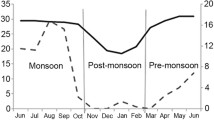Summary
Minor workers ofPheidole cephalica respond to small quantities of water placed in the nest entrance by making alarm runs through the nest, often ending at alternate entrances (fig. 1). They use odor trails to lead nestmates into the entrance galleries and sometimes away from the nest altogether. With this procedure one or two workers are able to mobilize a large fraction of the colony in 30 secs or less.
Standing water by itself is enough to induce the response, but moving water, which provides both chemical and tactile stimuli, is still more effective. Purely tactile stimulation does not evoke the response, even when vigorous enough to knock workers over. On the other hand, invasion by a single fire ant (Solenopsis invicta) often causes alarm runs, which are combined with alarm-recruitment to produce a composite pattern of defense and retreat distinct from flood evacuation.
The responses to flooding by 25 species ofPheidole in addition toP. cephalica have been tested. Some species react with both alarm runs and alarm waves, in which short loops generate broader and more slowly advancing fronts of excitement. Others respond with alarm waves alone. Alarm runs occur more frequently in species that nest in pieces of rotting wood, and hence typically excavate a linear array of nest galleries and chambers. They tend to be absent in species that nest in soil and hence to excavate a broader spread of cavities. The correlation proved significant in both the “liberal” test, in which all species were counted equally, and the “conservative” test, in which sets of closely related species were treated as single taxonomic units.
Zusammenfassung
Kleine Arbeiterinnen (minors) vonPheidole cephalica reagieren mit Alarmläufen wenn sie geringe Wassermengen am Nesteingang finden. Mit Hilfe von Duftspuren leiten sie Nestgenossen in die Nestgallerien und zu alternativen Eingängen. Auf diese Weise können ein bis zwei Arbeiterinnen einen grossen Teil der Kolonie innerhalb von 30 Sekunden mobilisieren.
Stehendes Wasser genügt die Reaktion auszulösen, aber fliessendes Wasser, das sowohl chemische wie taktile Stimuli bietet, ist noch wirksamer. Rein taktile Stimulation löst nicht diese Alarmreaktion aus, selbst wenn dabei die Ameise umgestossen wird. Das Eindringen einer einzelnen Feuerameise (Solenopsis invicta) löst oft jedoch Alarmläufe aus, die zusammen mit einer Alarm-Rekrutierung ein besonderes Verteidigungsverhalten darstellen, das deutlich unterschiedlich von der sogenannten Flutevakuierung ist.
NebenP. cephalica wurden zusätzlich bei 25Pheidole Arten die Reaktionen auf Flutgefahr getestet. Einige Arten reagieren mit Alarmläufen und “Alarmwellen”, andere nur mit “Alarmwellen”, bei denen kürzere Laufschleifen langsamer eine soziale Erregung auslösen. Alarmläufe werden häufiger bei Arten beobachtet, deren Nest in verfaulendem Holz angelegt ist, mit typischen längs verlaufenden Gallerien und Nestkammern. Arten die in der Erde nisten und deren Nester eine weitere Ausdehnung der Nestkammern haben, reagieren meistens mit “Alarmwellen”. Die Korrelation ist signifikant, sowohl im “liberalen” Test, bei dem alle Arten gleich gewertet wurden, als auch im “konservativen” Test, bei dem Gruppen näher verwandter Arten jeweils als eine taxonomische Einheit gewertet wurden.
Similar content being viewed by others
References
Buren W.F., Naves M.A., Carlysle T.C., 1977. — False phragmosis and apparent specialization for subterranean warfare inPheidole lamia Wheeler (Hymenoptera: Formicidae).J. Georgia Entomol. Soc., 12, 96–100.
Droual R., 1983. — The organization of nest evacuation inPheidole desertorum Wheeler andP. hyatti Emery (Hymenoptera: Formicidae).Behav. Ecol. Sociobiol., 12, 203–208.
Ridley M., 1983. —The explanation of organic diversity. Clarendon Press of Oxford University Press, Oxford.
Wilson E.O., 1976. — The organization of colony defense in the antPheidole dentata Mayr (Hymenoptera: Formicidae).Behav. Ecol. Sociobiol., 1, 63–81.
Wilson E.O., 1984. — The relation between caste ratios and division of labor in the ant genusPheidole (Hymenoptera: Formicidae).Behav. Ecol. Sociobiol., 16, 89–98.
Wilson E.O., Hölldobler B., 1985. — Caste-specific techniques of defense in the polymorphic antPheidole embolopyx (Hymenoptera: Formicidae).Insect. Soc., 32, 3–22.
Author information
Authors and Affiliations
Rights and permissions
About this article
Cite this article
Wilson, E.O. The organization of flood evacuation in the ant genusPheidole (Hymenoptera: Formicidae). Ins. Soc 33, 458–469 (1986). https://doi.org/10.1007/BF02223951
Received:
Accepted:
Issue Date:
DOI: https://doi.org/10.1007/BF02223951




